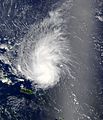Tropical wave facts for kids
Tropical waves, or easterly waves, also known as African easterly waves in the Atlantic Ocean, are a type of atmospheric trough, an extended area of moderately low air pressure, leaning north to south, which move from east to west across the tropics creating areas of cloudiness and thunderstorms. West-moving waves can also form from the tail end of frontal zones in the subtropics and tropics and may be called to as easterly waves, but these waves are not properly called tropical waves; they are a form of inverted trough sharing many characteristics with fully tropical waves. All tropical waves form in the easterly flow along the southern side of the subtropical ridge or belt of high pressure which is north and south of the Intertropical Convergence Zone (ITCZ). Tropical waves are normally carried westward by the prevailing easterly winds along the tropics and subtropics near the equator. They can lead to the formation of tropical cyclones in the north Atlantic and northeast Pacific Oceans. They can also lead to tropical storms which can also lead to hurricanes.
Characteristics
A tropical wave is usually preceded by an area of sinking, intensely dry air, sloping as a northeast wind. With the passage of the trough line, the wind turns to the southeast, the humidity suddenly rises, and the atmosphere destabilizes, producing widespread showers and thunderstorms, sometimes severe. As the wave moves off westward, the showers slowly stop.
A notable exception to the general characteristic of widespread precipitation behind a tropical wave occurs in the Atlantic. Periodically, a surge of intensely dry air known as the Saharan Air Layer (SAL) is entrained behind a tropical wave, resulting in cloudless or nearly cloudless skies as convection is limited by the dry layer inversion. Also, any dust which may be present within the SAL reflects solar radiation, slightly cooling the atmosphere below it.
Atlantic
Tropical waves in the Atlantic Ocean form from disturbances which drift off the continent of Africa onto the Atlantic Ocean. These are generated or enhanced by the African Easterly Jet. The clockwise circulation of the large transoceanic high-pressure cell or anticyclone centered near the Azores islands impels easterly waves away from the coastal areas of Africa to North America. About 60% of Atlantic tropical cyclones originally form from tropical waves, while about 85% of intense Atlantic hurricanes (Category 3 and greater) form from tropical waves.
Tropical cyclones can sometimes degenerate back into a tropical wave. This normally happens if upper-level wind shear is too strong. The storm can redevelop if the upper level shear decreases or stops. If a tropical wave is moving quickly, it can have strong winds of over tropical storm force, but is not considered a tropical storm unless it has a closed circulation.
East Pacific
It has been suggested that eastern Pacific Ocean tropical cyclones are formed out of tropical waves that come from North Africa as well. During the summer months, tropical waves can go northward as far as the desert southwest of the United States, producing spells of intensified shower activity surrounded within the current monsoon area.
Related pages
Images for kids
-
2013's Tropical Storm Dorian as a tropical wave on July 29
See also
 In Spanish: Onda tropical para niños
In Spanish: Onda tropical para niños


